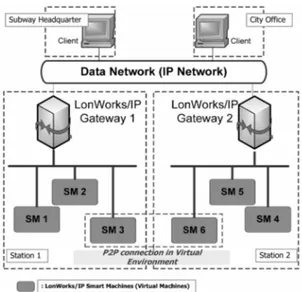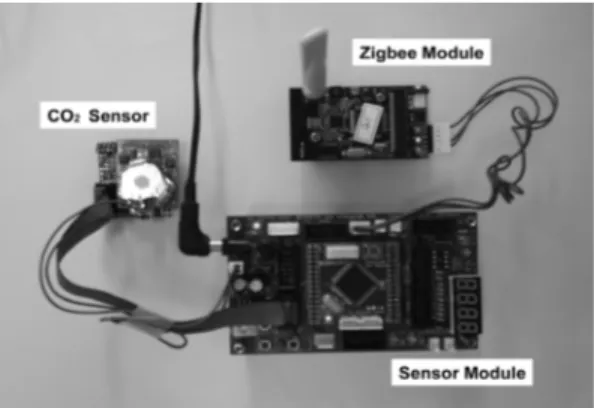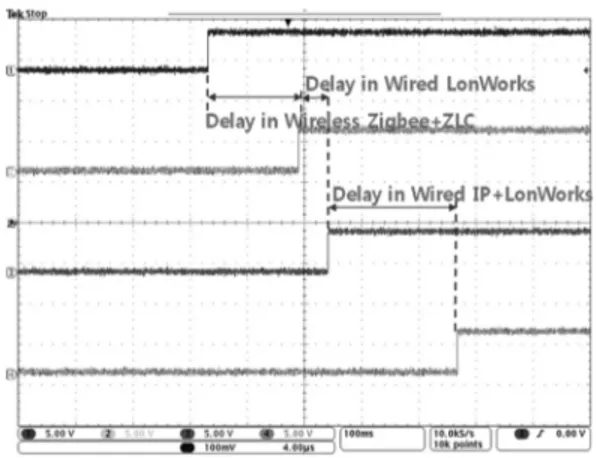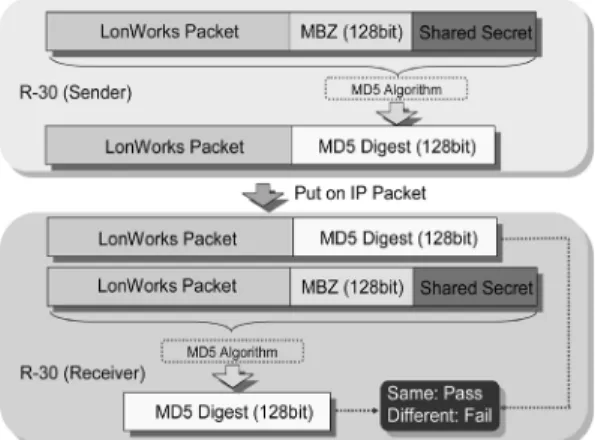성능평가에 관한 연구
최 기 흥
한성대학교 기계시스템공학과 (2011. 4. 19. 접수 / 2012. 1. 3. 채택)
Performance Evaluation of Wireless and Wired Networks for Monitoring and Control of Indoor Air Quality(IAQ) in Subway Stations
Gi Heung Choi
Department of Mechanical Systems Engineering, Hansung University (Received April 19, 2011 / Accepted January 3, 2012)
Abstract : In crowded subway stations indoor air quality (IAQ) is a key factor for ensuring the safety and health of passengers. Since physical variables that describing IAQ such as the concentration of particulate, CO2, VOCs and biological agents need to be closely monitored and controlled in multiple locations within subway stations and in remote sites, concept of web-based monitoring and control network using both wireless and wired media needs to be implemented. Connecting remote wireless sensor network and device (LonWorks) networks to the IP network based on the concept of VDN can provide a powerful, integrated, distributed monitoring and control performance. In this study, performance of wireless and wired network in VDN for monitoring and control of IAQ in subway stations is evaluated. Specifically, delay induced in wireless and wired networks, and data transmission rate are evaluated. A key parameter is identified in assuring safety and health of passengers in subway stations.
초 록 : 복잡한 지하철 역사에서 공기질은 승객의 안전과 건강을 좌우하는 중요한 요소이다. CO2,VOCs먼지, 미생물 등의 농도는 역사의 여러 지점에서뿐만 아니라 원격지점에서도 감시 및 제어가 가능해야 하기 때문에 유 무선 네트워크를 사용한 웹기반 감시 및 제어가 필요하다. 가상디바이스 네트워크(VDN) 개념에 근거한 원격 무 선센서 네트워크와 디바이스 네트워크(LonWorks)를 IP 네트워크에 연동시키면 매우 강력한 분산 감시 및 제어 성능을 제공한다. 본 연구에서는 지하철역사내 공기질 감시 및 제어를 위한 유무선 네트워크의 성능평가를 실 시하였다. 특히 유무선 네트워크의 데이터 전송과 지연특성을 평가하고 승객의 안전과 건강을 위한 핵심요소를 확인하였다.
Key Words : zigbee network, lonWorks network, IAQ(in-door air quality), safety, health
1. Introduction
*In subway stations in-door air quality(IAQ) is a key factor for ensuring the safety and health of passengers.
Standard definition of IAQ that is specific to subway stations is not available. However, in terms of assu- ring the safety andhealth of occupants in a more gene- ric building environment, IAQ can be defined as the physical, chemical and biological properties that indoor air must have in order not to cause or aggravate illness
gihchoi@hansung.ac.kr
of occupants, and to secure high level of safety and health to the occupants in the performance of the de- signated activities for which the station has been in- tended and designed.1-5) In subway stations intensive and customized information on IAQ has to be provided to operators and also to passengers.
In this study, in view of safety and health manage- ment in VDN environment, performance of web-based monitoring and control of IAQ in subway stations is evaluated. A basic framework for wireless sensor net- work using LonWorks/IP Gateway/Web server is su- ggested to better perform monitoring and control of
IAQ. Specifically, a method to guarantee interopera- bility between devices is also suggested. Delay induced in wireless network and wired networks such as Lo- Works and IP networks is also evaluated and a key parameter is identified for performance of web-based monitoring and control of IAQ.
2. Web-based monitoring and control of indoor air quality
The important factors affecting IAQ not only in subway stations but in building environment in gene- ral are known to be particulate matters, CO, NO2, O- zone, VOCs(Volatile Organic Compounds), radon, el- ectromagnetic fields, chemical agent, and Environmen- tal Tobacco Smoke(ETS) and biological agentsin6). In the previous study7,8) the average values of particulate (PM10) were measured at multiple locations in several subway stations in Busan, Korea. The measured results indicate that particulate in indoor air appears, as ex- pected, to be denser than in outdoor air. Tunnel and platform are the weakest locations for the health of passenger. The results suggest that improving IAQ of subway station needs multiple measurements in mul- tiple locations. In order to make indoor station more comfortable, ventilation methods must also be upgraded in tunnels and platforms.
These issues imply that large amount of data need to be collected and processed effectively in the field.
Real-time feedback on the conditions of pollutant so- urces, indoor/outdoor air quality and activities in the stations as well as device, equipment and facilities is also required for efficient management and control of IAQ.
“Virtual Device Network”(VDN) includes one or more remote sites connected with one or more moni- toring/control applications located on the Internet. The typical architecture of a VDN is shown in Fig. 19,10). One example is virtual machine(VM) or smart machine (SM), which utilizes VDN. In this configuration, mo- nitoring and control IAQ, safety and health manage- ment and predictive maintenance, for example, can be performed both in the subway stations and in remote site through internet.
Fig. 1. Typical architecture of VDN that requires the IP net- work with the local control network such as LonWorks network through LonWorks/IP gateway/web server.
The other key concept to this architecture is the peer-to-peer communication. Fire accident in 2003 in a subway station in the city of Deagu in Korea which killed nearly 200 passengers indicates that such con- figuration is particularly effective in ensuring thesafety of passengers. Communication and transfer of moni- toring and control data between two adjacent stations, ventilation control for example, needs to be assured to secure proper safety management and to save lives of passengers in case of fire, or any disaster.
Considering the fact that physical properties, pollu- tants are closely monitored and controlled in multiple locations in the subway station, concept of distributed monitoring and control network such as LonWorks net- work needs to be implemented.
3. Framework for wireless sensor network
The suggested framework was designed to deal with the wired communication media such as twisted pair (TP), and the Zigbee wireless media. Fig. 2 shows the concept of LonWorks/IP smart machine using various communication media for monitoring and control of IAQ. Wireless media such as Zigbee was suggested for ease of installation. Simple tests, however, showed that electromagnetic interference due to power line of the train especially when the train moves along theFig. 2. Concept of LonWorks/IP smart machine using various communication media for monitoring and control of IAQ.
platform severely degrades the real-time transmission performance of the wireless media. In that case, twisted pair communication media must be used. Power line media was considered for the case where twisted pair communication channel can hardly be installed due to complexity of structure of the station.
4. Experiment
A simple networking test in a laboratory was per- formed to assess the transmission characteristics of wi- reless communication using Zigbee modules under busy and hostile environment. The sensor node was set to generate the sensing data every 10 sec. Each sensor node was composed of sensor module linked to a Zig- bee wireless communication module so that the node transmits the sensor readings to the receiver node whi- ch is Zigbee to LonWorks converter(ZL converter) in Fig. 2. Fig. 3 shows the composition of each sensor node. Data rate for wireless network, LonWorks net- work and IP network were set to 9,600 bps, 78 kbps and more than 1 Mbps, respectively. These data rates were far beyond the bandwidth of sensor signal. The transmission power of 2.4 GHz Zigbee module was 1 mW.
Network configuration used to test the delay in net- works is as follows: In this virtual devie network (VDN) environment in Fig. 4, the wireless device net- work was composed of LonWorks/IP web server, I/O
Fig. 3. A example of sensor node constructed using CO2 sen- sor module, sensor module and Zigbee wireless com- munication module.
Fig. 4. Network configuration in VDN environment.
devices, Zigbee to LonWorks protocol converter. The sensor data were gathered in local sensor node which is connected to local Zigbee node, and transmitted to ZL converter through wireless media andthen to Lon- Works/IP server. LonWorks/IP packet then transmitted to other LonWorks/IP server which in turn passes the packet data to destination I/O device bound to it.
Destination devices in this case actuate the HVAC facilities to control IAQ. Any client on the IP network can access to the local network and monitor the sensor data in remote site. 1Hz pulse input was used to test the time delay in each network set. The output signals in destination device in four network sets were mea- sured in oscilloscope.
5. Results and discussion 5.1. Network delay
Fig. 5 shows such outputs for network configuration in this study. The first signal is the original input si- gnal for tests. Second signal is the one received by ZL converter. Third signal is the one measured at the de-
Fig. 5. Example of network delay measured. The first signal is the original input pulse signal and the second one is the signal received by ZL converter. The third signalis the one measured at the destination device directly connected to ZL converter. The last signal was mea- sured at the destination device when it was connected to the remote LonWorks/IP server.
stination device directly connected to ZL converter.
The last signal was measured at the destination device when it was connected to the remote LonWorks/IP server. A thousand pulse input signals were generated and their delay was measured.
Fig. 6. shows the histogram of the delay of received signals in network configuration used in this study.
Network delay when the destination device directly connected to ZL converter without IP network con- nection was also measured for comparison purpose.
Network delay in the range of 230~530 ms were for measured in network configuration used in this study.
For the configuration without IP network connected, however, delay of 190~240 ms was measured. Addi- tional delay of up to 340 ms was then due to delay in IP network and data processing in LonWorks/IP server.
The measured delay is widely and evenly spread over the 240 to 430 ms range where the sensor data of dis- crete nature were transmitted.
In Fig. 7, the transmission delay in wireless media appears to be within a narrow range of 150~160 ms.
Noting that the transmission delay in the local wired media such as LonWorks network is in the range of 13~26 ms11), delay in transmitting the IP packet in Fig. 6 is estimated to beminimal and does not surpass that in local LonWorks network in relatively short dis- tance within a cityand data conversion appears to con-
Fig. 6. Network delay in transmission of data.
Fig. 7. Network delay in transmission of data through wireless media.
sume more time. Such distribution in Fig. 6, therefore, indicates that attention needs to be paid to efficient and fast conversion of transmission data in both ZL converter and LonWorks/IP server. Compared to 200 seconds of sensing interval used for this type of sys- tems in practice, delay in this range, however, does not appear to be a major setback.
5.2. Data transmission rate in subway station
Preliminary test results in the subway station showed that data loss occurred as the distance between two ad- jacent sensor nodes becomes longer3,4). The number of data received for a Zigbee module located 35 meters away from the sensor node on the same floor, for ex- ample, was around 70% of all data transmitted. It is, however, noticed that as the node moves two to three meters away from the stairway tothe lower floor data reception was impossible. In case of inter-floors com- munication, the communication distance becomes much shorter than planar case and is estimated to be lessthan 30 meters. The maximum transmission power of Zigbee node used was 1 mW which requires the ad- hoc use of such nodes to guarantee the usefulness of wireless data communication in metro station environ- ments. Another possible way to guarantee the whole reception of sensor reading is to use wired network for inter-stairs communication and wireless communication for each floor.
Test results also indicate that wireless communica- tion within the visible distance of up to 30 meters can insure 100% data reception. It is, however, noted that visibility is very important in assuring the data recep- tion when 2.4 GHz data band is used. For example, data reception rate without any visibility was below 50%. Therefore, it is crucial to use 2.4 GHz wireless media such as Zigbee module only when the visibility is assumed. An alternative way is to use lower base band frequency wireless communication media. For, example, using 10 mW 424 MHz wireless media sig- nificantly improves the reception rate to 97% in 150 meters of distance with visibility, compared to 58%
with 10 mW 2.4 GHz Zigbee module. Between stairs reception rate without any visibility for 424 NHz mo- dule marked 98%, compared to 39% with 2.4 GHz module.
5.3. Security issues in the IP network
Another critical issue in IP network is the data se- curity. LonWorks/IP data transmission is performed by the tunneling technique which is the core part of EIA/
CEA-852 standard. Fig. 8 depicts a security check logic described in EIA/CEA-852 LonWorks/IP tunneling st- andard. A tunneling technique encodes the communi- cation packet of LonWorks including address infor- mation device networks as well as the network variable binding information into the data packet of an IP pro- tocol. Data(LonWorks packet) and the 128 bit secrete word are then encoded using MD 5 algorithm to con- struct an IP packet. This packet is transmitted to the receiving LonWorks/IP web server where the decoding process is performed. The receiving LonWorks/IP web server first encodes the transmitted data with its own 128 bits secrete word to check if the packet is from the authorized web server. Once the security check is passed, it transmits the LonWorks data to the desti-
Fig. 8. MD 5 authentication as specified by EIA/CEA 852 Lon- Works/IP tunneling standard.
nation device on the lower device network according to the NV binding information it received. A Lon- Works/IP web server on virtual device networks be- comes a connection pass, which can transmit and re- ceive the data/information of device networks safely in this method.
6. Conclusion
A basic framework for wireless wired network in VDN environment that can be applied to IAQ manage- ment in subway station was suggested. Since the phy- sical variables need to be closely monitored and con- trolled in multiple locations in the subway stations, the concept of distributed monitoring and control network need to be implemented. The suggested framework was designed to deal with the wireless communication me- dia using Zigbee or 424 MHz media, the wired twi- sted pair(TP) local network and wide area IP network.
Simple preliminary test indicates that delay in trans- mitting the data is not a severe setback in reality. It is, however, crucial to use 2.4 GHz wireless media such as Zigbee module only when the visibility is as- sumed. An alternative way is to use lower base band frequency wireless network using 424 MHz wireless media. Attention also needs to be paid to efficient and fast conversion of transmission data in both Zigbee to LonWorks converter and LonWorks/IP server.
Acknowledgement : This research was supported by Hansung University in the year 2010.
References
1) Gi Heung Choi and Gi Sang Choi, “A Framework for Web-based Monitoring and Control of Indoor Air Quality(IAQ) in Metro Subway Station”, Proceedings of International Symposium on Safety Science and technology, Beijing, China, pp. 2514~2518, July 2008.
2) Gi Heung Choi and Gi Sang Choi, “Design of Service System Framework for Web-based Monitoring and Control of Indoor Air Quality(IAQ) in Subway Sta- tions”; Proceedings of NISS, Beijing, China, 2009.
3) Gi Heung Choi, Gi Sang Choi and Joo Hyoung Jang,
“A Framework for Wireless Sensor Network in Web- based Monitoring and Control of Indoor Air Quality (IAQ) in Subway Stations”; Proceedings of Interna- tional Conference on Computer Science and Informa- tion Technology, Beijing, China, Vol. 2, pp. 278~382, 2009.
4) Gi Heung Choi, Gi Sang Choi and Joo Hyoung Jang,
“Performance Evaluation of Wireless Sensor Network in Web-based Monitoring and Control of Indoor Air Quality(IAQ) in Subway Stations”, Proceedings of the Asia-Pacific Symposium on Safety(APSS), Osaka, Ja- pan, pp. 165~169, 2009.
5) Sung Hoon Kwak, “A Study on Web-based Environ- mental Monitoring System Using LonWorks/IP Server”, MS Thesis, Dept. Electrical Engineering and Computer
Science, University of Seoul, 2009.
6) Ben Bronsema, et al, “Performance Criteria of Buildings for Health and Comfort”, Report of ISIAQ-CIB, Task Group TG42, 2004.
7) Hwa Woon Lee, Jong-kil Park, Nam-Sim Jang, Hee- Ryung Lee, and Hee-Man Kim, “Analysis of Ambient Air Quality Level in Subway Area in Busan Metro- politan City”, J. Environmental Science, Vol. 2, pp.
207~215, 2003.
8) Jung-Wook Chang, Jang-Je Cho, Woo-Gun Choi, Duk- Sin Park, Woo-Sung Jung and Tae-Oh kim, “A Study of PM-10 and Heavy Metal Characteristics in the air at the each site of subway station”, J. Environmental Science, Vol. 4, pp. 125~129, (in Korean), 2005.
9) G. H. Choi, “Lonworks Based Virtual Device Net- work(VDN) for Predictive Maintenance”, Proc. KOSOS Fall Conference, Samchuk, pp. 324~327, (in Korean), 2008.
10) Sung Hoon Kwak, “A Study on Web-based Environ- mental Monitoring System Using LonWorks/IP Server”
MS Thesis, Dept. Electrical Engineering and Computer Science, University of Seoul, 2009
11) Ki Won Song, Gi Sang Choi, Gi Heung Choi and Jung Soo Kim, “Integration of Distributed Control Net- works with IP Networks for Remote Control and Mo- nitoring”, Proc. ICMIT 2001, Yamaguchi, Japan, pp.
377~380, Dec. 2001



